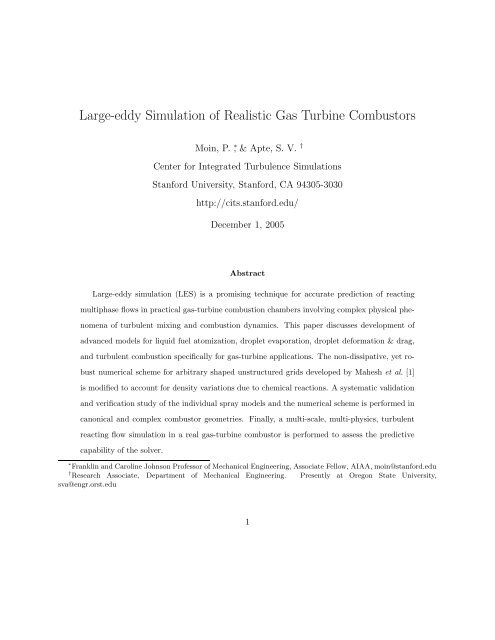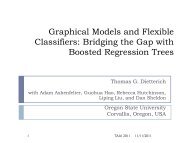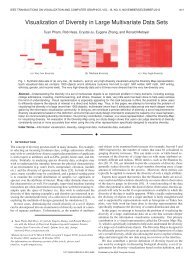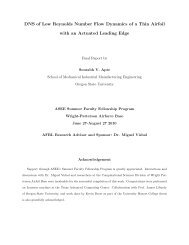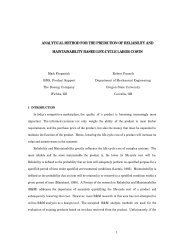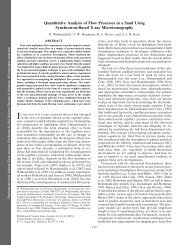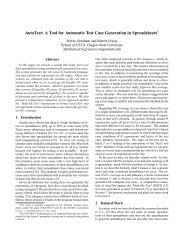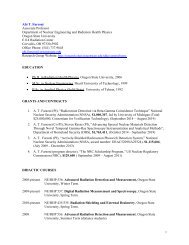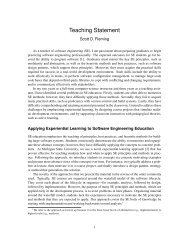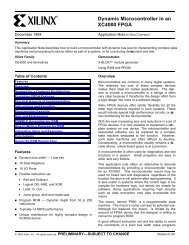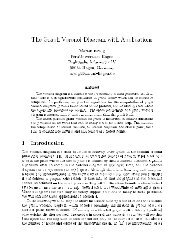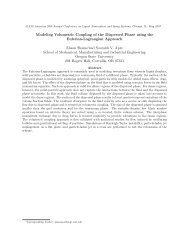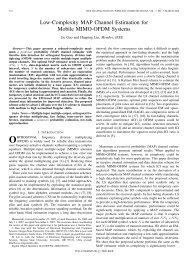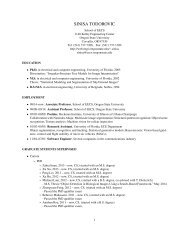Large-eddy Simulation of Realistic Gas Turbine Combustors
Large-eddy Simulation of Realistic Gas Turbine Combustors
Large-eddy Simulation of Realistic Gas Turbine Combustors
You also want an ePaper? Increase the reach of your titles
YUMPU automatically turns print PDFs into web optimized ePapers that Google loves.
<strong>Large</strong>-<strong>eddy</strong> <strong>Simulation</strong> <strong>of</strong> <strong>Realistic</strong> <strong>Gas</strong> <strong>Turbine</strong> <strong>Combustors</strong><br />
Moin, P. ∗ , & Apte, S. V. †<br />
Center for Integrated Turbulence <strong>Simulation</strong>s<br />
Stanford University, Stanford, CA 94305-3030<br />
http://cits.stanford.edu/<br />
December 1, 2005<br />
Abstract<br />
<strong>Large</strong>-<strong>eddy</strong> simulation (LES) is a promising technique for accurate prediction <strong>of</strong> reacting<br />
multiphase flows in practical gas-turbine combustion chambers involving complex physical phenomena<br />
<strong>of</strong> turbulent mixing and combustion dynamics. This paper discusses development <strong>of</strong><br />
advanced models for liquid fuel atomization, droplet evaporation, droplet deformation & drag,<br />
and turbulent combustion specifically for gas-turbine applications. The non-dissipative, yet robust<br />
numerical scheme for arbitrary shaped unstructured grids developed by Mahesh et al. [1]<br />
is modified to account for density variations due to chemical reactions. A systematic validation<br />
and verification study <strong>of</strong> the individual spray models and the numerical scheme is performed in<br />
canonical and complex combustor geometries. Finally, a multi-scale, multi-physics, turbulent<br />
reacting flow simulation in a real gas-turbine combustor is performed to assess the predictive<br />
capability <strong>of</strong> the solver.<br />
∗ Franklin and Caroline Johnson Pr<strong>of</strong>essor <strong>of</strong> Mechanical Engineering, Associate Fellow, AIAA, moin@stanford.edu<br />
† Research Associate, Department <strong>of</strong> Mechanical Engineering. Presently at Oregon State University,<br />
sva@engr.orst.edu<br />
1
1 Introduction<br />
The combustion chambers <strong>of</strong> gas-turbine based propulsion systems involve complex phenomena<br />
such as atomization <strong>of</strong> liquid fuel jets, evaporation, collision/coalescence <strong>of</strong> droplets,<br />
and turbulent mixing <strong>of</strong> fuel and oxidizer giving rise to spray-flames. Accurate observations<br />
and quantitative measurements <strong>of</strong> these processes in realistic configurations are difficult and<br />
expensive. Better understanding <strong>of</strong> these flows for design modifications, improvements, and exploring<br />
fundamental physics demands high-fidelity numerical studies in realistic configurations.<br />
Specifically, good predictive capability for swirling, highly turbulent reacting flows in complex<br />
geometries is necessary.<br />
To date the engineering prediction <strong>of</strong> such flows in realistic configurations has relied predominantly<br />
on the Reynolds-averaged Navier-Stokes equations (RANS) [2, 3]. In RANS, turbulence<br />
models for the Reynolds stress tensor provide time (or ensemble) -averaged solutions to the<br />
Navier-Stokes equations. Though computationally efficient, RANS-based models for two-phase<br />
reacting flows do not represent the relevant flow quantities accurately even in simple configurations.<br />
LES and direct numerical simulation (DNS) techniques have been shown to give good<br />
predictions <strong>of</strong> turbulent flows in simple configurations [4]. Recently, Pierce & Moin [5] have<br />
shown the superiority <strong>of</strong> LES to RANS in accurately predicting turbulent mixing and combustion<br />
dynamics in a coaxial combustor geometry. Kim & Syed [6] and Mongia [7] provide a<br />
detailed overview on the importance and role <strong>of</strong> LES in designing advanced gas-turbine combustors.<br />
The flowfield inside the combustor is highly swirling, separated and turbulent with<br />
complex features such as mixing <strong>of</strong> secondary cooling air with hot combustion products. The<br />
spray flame is stabilized by the recirculation bubble created by swirling flow. Multiple, turbulent<br />
jets in cross flow play an important role in scalar mixing; may influence pollutant formation,<br />
and elimination <strong>of</strong> any ‘hot-spots’ in the combustor exit. LES is considered very attractive in<br />
predicting these flow features and their sensitivity to design modifications. However, presently<br />
LES has largely been used to investigate flows in simple configurations. Our goal is to extend<br />
the LES methodology to realistic geometries involving complex physics <strong>of</strong> multiphase, reacting<br />
2
flows.<br />
In LES, three-dimensional, unsteady Navier-Stokes equations are spatially filtered, the large<br />
scales are computed directly, and only the effect <strong>of</strong> unresolved subgrid scales is modeled. The<br />
penalty is increased computational cost. In addition, the numerical algorithms used for LES<br />
must be energy conserving and strictly non-dissipative, as numerical dissipation has been shown<br />
to be detrimental in accurate prediction <strong>of</strong> turbulent flows [8]. Furthermore, the complex geometry<br />
<strong>of</strong> practical combustors necessitates use <strong>of</strong> unstructured grids due to the flexibility they<br />
<strong>of</strong>fer in handling complex configurations as well as significant savings in the number <strong>of</strong> control<br />
volumes as compared to the body-fitted structured grids.<br />
Recently, Mahesh et. al. [1] have developed a new numerical method with the characteristics<br />
necessary for simultaneously accurate and robust LES on unstructured grids. These competing<br />
ends were achieved by developing a method around the principle <strong>of</strong> discrete kinetic energy<br />
conservation with no artificial dissipation. Based on this numerical scheme, a parallel, arbitrary<br />
elements, unstructured grid, finite-volume code has been developed specifically to perform<br />
LES <strong>of</strong> complex combustor geometries. The solver is named after late Charles David Pierce<br />
(1969-2002) who made several lasting contributions to the LES <strong>of</strong> reacting flows. The original<br />
incompressible formulation by Mahesh et al. [1] is extended to simulate variable density,<br />
low-Mach number flows with integrated models for turbulent combustion and spray dynamics<br />
[9, 10, 11]. In order to trust the numerics and know the limitations <strong>of</strong> the models used, a<br />
systematic validation and verification study evaluating their predictive capability is <strong>of</strong> utmost<br />
importance. Detailed experiments independently addressing droplet dispersion, droplet evaporation,<br />
breakup, and turbulent combustion (with gaseous fuel) have been performed, however,<br />
experiments involving multiphase reacting flows in simplified combustors are needed to further<br />
advance the models for spray dynamics and turbulent combustion.<br />
In the following sections, the mathematical formulation for gas and liquid phases, advanced<br />
subgrid models for droplet breakup, evaporation, deformation, and drag are described. Results<br />
from numerous validation studies performed are reported. Ongoing efforts to further develop<br />
advanced physical models and numerical algorithms for improved speedup are summarized.<br />
3
2 Mathematical Formulation<br />
We solve the variable density, low-Mach number, Navier-Stokes equations for the gas-phase.<br />
The formulation is based on flamelet progress-variable (FPV) approach developed by Pierce<br />
& Moin [5] for LES <strong>of</strong> non-premixed, turbulent combustion.<br />
The liquid phase is treated in<br />
the Lagrangian framework with efficient particle tracking scheme on unstructured grids, which<br />
allows simulation <strong>of</strong> millions <strong>of</strong> independent droplet trajectories. A summary <strong>of</strong> the filtered<br />
Eulerian/Lagrangian equations and subgrid models for unclosed terms and droplet dynamics is<br />
given below.<br />
2.1 Filtered LES Equations for <strong>Gas</strong>-Phase<br />
The gas phase continuity, scalar, and momentum equations are,<br />
∂ ( ρ g ũ j<br />
)<br />
∂x j<br />
= − ∂ρ g<br />
∂t + Ṡm (1)<br />
( )<br />
∂ ρ g ˜Z<br />
∂t<br />
( )<br />
∂ ρ g ˜C<br />
∂t<br />
∂ ( ρ g ũ i<br />
)<br />
∂t<br />
+<br />
+<br />
)<br />
(<br />
∂<br />
(ρ g ˜Zũj<br />
= ∂ ∂<br />
ρ<br />
∂x j ∂x g ˜α ˜Z<br />
)<br />
Z − ∂q Zj<br />
+<br />
j ∂x j ∂x ṠZ (2)<br />
j<br />
)<br />
(<br />
∂<br />
(ρ g ˜Cũj<br />
= ∂ ∂<br />
ρ<br />
∂x j ∂x g ˜α ˜C<br />
)<br />
C − ∂q Cj<br />
+ ˙ω C (3)<br />
j ∂x j ∂x j<br />
+ ∂ ( ρ g ũ i ũ j<br />
)<br />
∂x j<br />
= − ∂p + ∂(2µ ˜S ij )<br />
− ∂q ij<br />
+<br />
∂x i ∂x j ∂x Ṡi (4)<br />
j<br />
where<br />
˜S ij = 1 ( ∂ũi<br />
+ ∂ũ )<br />
j<br />
2 ∂u j ∂u i<br />
− 1 3 δ ∂ũ k<br />
ij . (5)<br />
∂x k<br />
Here ρ g is the gas-phase density, u j the velocity vector, p the pressure, µ the dynamic<br />
viscosity, δ ij the Kronecker symbol, Z the mixture fraction, C the progress variable, α Z and α C<br />
the scalar diffusivities, and ˙ω C the source term due to chemical reactions. The additional term<br />
4
in the continuity, Ṡ m , mixture fraction, Ṡ Z , and momentum equations, Ṡ i , are the interphase<br />
mass and momentum transport terms. The unclosed transport terms in the momentum and<br />
scalar equations are grouped into the residual stress, q ij , and residual scalar fluxes, q Zj , q Cj .<br />
The filtering operation is denoted by an overbar and Favre (density-weighted) filtering by tilde.<br />
The choice <strong>of</strong> the progress variable depends on the flow conditions and chemistry. Typically,<br />
mass fractions <strong>of</strong> major product species is a good indicator <strong>of</strong> the forward ‘progress’ <strong>of</strong> the<br />
reaction.<br />
2.2 Presumed P DF approach<br />
Following the FPV appraoch [5], the chemistry is incorporated in the form <strong>of</strong> a steady-state<br />
one-dimensional flamelet model. Due to the presence <strong>of</strong> the liquid phase, the transport equation<br />
for the mixture fraction (defined based on the fuel vapor) has a source term (Eq. 2). In addition,<br />
the heat <strong>of</strong> droplet vaporization is taken from the gas-phase causing evaporative cooling <strong>of</strong> the<br />
surrounding gas. This gives rise to a sink term in the energy equation. The evaporative cooling<br />
effect is accounted for during the generation <strong>of</strong> the flamelet tables by computing an effective<br />
gaseous fuel temperature, T fuel,g = T fuel,l − L vap /C pl , where subscript l stands for liquid, L vap<br />
is the latent heat <strong>of</strong> vaporization, and C pl the specific heat <strong>of</strong> liquid fuel, and T fuel,l the inlet<br />
liquid fuel temperature. This effective gaseous fuel temperature is used as boundary condition in<br />
solving the flamelet equations. By assuming adiabatic walls and unity Lewis number, the energy<br />
and mixture fraction equations have the same boundary conditions and are linearly dependent.<br />
The energy conservation equation is not solved in this formulation.<br />
The subgrid fluctuations in the mixture fraction and progress variable, filtered combustion<br />
variables are obtained by integrating chemical state relationships over the joint P DF <strong>of</strong> Z and<br />
C. As an example, the filtered chemical source term <strong>of</strong> the progress variable is given as,<br />
∫<br />
˙ω C =<br />
˙ω C (Z, C) ˜P (Z, C)dZdC. (6)<br />
The joint subgrid P DF is modeled by writing, ˜P (Z, C) = ˜P (C|Z) ˜P (Z). Here, ˜P (Z) is modeled<br />
5
y the presumed beta subgrid P DF and the conditional P DF , ˜P (C|Z) is modeled as a delta<br />
function according to Pierce & Moin [5]. In the present two-phase flow application, the mixture<br />
fraction equation (Eq. 2) consists <strong>of</strong> a source term due to the evaporation <strong>of</strong> liquid fuel. By<br />
assuming a beta P DF for ˜P (Z) we implicitly assume that the time-scale <strong>of</strong> evaporation is small<br />
compared to the scalar mixing time-scale. More advanced micro-mixing models accounting for<br />
spray-chemistry interactions are necessary [12] to better represent the filtered source terms in the<br />
continuity and mixture-fraction equations. Following these assumptions, the flamelet library is<br />
computed and subgrid P DF integrals are evaluated to generate lookup tables to provide filtered<br />
variables as:<br />
ỹ i = ỹ i ( ˜Z, ˜Z ′′ 2<br />
, ˜C), ˜T = ˜T ( ˜Z, ˜Z ′′ 2<br />
, ˜C), ρ g = ρ g ( ˜Z, ˜Z ′′ 2<br />
, ˜C), etc. (7)<br />
where ˜Z ′′ 2<br />
is the mixture fraction variance, ỹ i the species mass fractions, and ˜T the temperature.<br />
Similar expressions are obtained for dynamic viscosity, molecular diffusivities, and other<br />
properties required in the computation.<br />
2.3 Subgrid Scale Models<br />
The dynamic Smagorinsky model by Moin et al. [13] is used to close the subgrid terms as<br />
demonstrated by Pierce & Moin [14]. The unclosed terms in Eqs. (2-4) are modeled using the<br />
<strong>eddy</strong>-viscosity assumption. The <strong>eddy</strong> viscosity, <strong>eddy</strong> diffusivities, and subfilter variance <strong>of</strong> the<br />
mixture fraction are evaluated as:<br />
µ t = C µ ρ g ∆ 2 |˜S|, ρ g α t = C α ρ g ∆ 2 |˜S|, ρ g<br />
˜Z ′′ 2<br />
= C ˜Zρ g ∆ 2 | ▽ ˜Z| 2 (8)<br />
where |˜S| =<br />
√<br />
˜Sij ˜Sij . The coefficients C µ , C α , and C ˜Z<br />
are evaluated dynamically [14].<br />
6
2.4 Liquid-Phase Equations<br />
The droplet motion is simulated using the Basset-Boussinesq-Oseen (BBO) equations [15]. It<br />
is assumed that the density <strong>of</strong> the droplet is much larger than that <strong>of</strong> the fluid (ρ p /ρ g ∼ 10 3 ),<br />
droplet-size is small compared to the turbulence integral length scale, and that the effect <strong>of</strong><br />
shear on droplet motion is negligible. The high value <strong>of</strong> density ratio implies that the Basset<br />
force and the added mass term are small and are therefore neglected. Under these assumptions,<br />
the Lagrangian equations governing the droplet motions become<br />
du p<br />
dt<br />
dx p<br />
dt<br />
= u p , (9)<br />
(<br />
= D pdrop (u − u p ) + 1 − ρ )<br />
g<br />
g (10)<br />
ρ p<br />
where x p is the position <strong>of</strong> the droplet centroid, u p the droplet velocity components, u the gasphase<br />
velocities interpolated to the droplet location, ρ p & ρ g the droplet and gas-phase densities,<br />
and g the gravitational acceleration. The drag force on a droplet is modeled by drag coefficient,<br />
C d , based on a solid particle with modifications due to internal circulation and deformation,<br />
D psolid = 3 4 C ρ g |u g − u p |<br />
d<br />
(11)<br />
ρ p d p<br />
where C d is obtained from the nonlinear correlation [15]<br />
C d = 24 ( )<br />
1 + aRe<br />
b<br />
Re<br />
p . (12)<br />
Here Re p = d p |u g − u p |/µ g is the particle Reynolds number. The above correlation is valid for<br />
Re p ≤ 800. The constants a = 0.15, b = 0.687 yield the drag within 5% from the standard drag<br />
curve. The above expression for solid body drag is modified to account for droplet deformation<br />
and internal circulation as given below.<br />
In LES <strong>of</strong> droplet-laden flows, the droplets are presumed to be subgrid, and the droplet-size<br />
is smaller than the filter-width used. The gas-phase velocity field required in Eq. (10) is the total<br />
7
(unfiltered) velocity, however, only the filtered velocity field is computed in Eqs. (4). The direct<br />
effect <strong>of</strong> unresolved velocity fluctuations on droplet trajectories depends on the droplet relaxation<br />
time-scale, and the subgrid kinetic energy. Pozorski et al. [16] performed a systematic study<br />
<strong>of</strong> the direct effect <strong>of</strong> subgrid scale velocity on particle motion for forced isotropic turbulence.<br />
It was shown that, in poorly resolved regions, where the subgrid kinetic energy is more than<br />
30%, the effect on droplet motion is more pronounced. A stochastic model reconstructing the<br />
subgrid-scale velocity in a statistical sense was developed [16]. In the present work, we neglect<br />
this direct effect <strong>of</strong> subgrid scale velocity on the droplet motion. However, note that the particles<br />
do feel the subgrid scales through the subgrid model that affects the resolved velocity field. For<br />
swirling, separated flows with the subgrid scale energy content much smaller than the resolved<br />
scales, the direct effect was shown to be small [9].<br />
2.4.1 Deformation and drag models<br />
The drag law for spherical, solid objects (Eq. 11) needs modifications when applied to liquid<br />
droplets in a turbulent flow. Droplet deformation and internal circulation may affect the drag<br />
force significantly. In order to quantify the effect <strong>of</strong> droplet deformation on drag, Helenbrook &<br />
Edwards [17] performed detailed resolved simulations <strong>of</strong> axisymmetric liquid drops in uniform<br />
gaseous stream. Based on their computations for a range <strong>of</strong> density and viscosity ratios, range<br />
<strong>of</strong> Weber (W e), Ohnesorge (Oh), and Reynolds numbers (Re), a correlation was developed that<br />
provides the amount <strong>of</strong> droplet deformation in the form <strong>of</strong> ellipticity, E, which is defined as the<br />
ratio <strong>of</strong> the height to width <strong>of</strong> the drop,<br />
√<br />
E = 1 − 0.11W e 0.82 ρp µ g<br />
+ 0.013 Oh −0.55 W e 1.1 (13)<br />
ρ g µ l<br />
where µ l , µ g are the viscosities, and ρ p , ρ g the densities <strong>of</strong> the liquid and gas-phase, respectively.<br />
The non-dimensional Weber and Ohnesorge numbers are defined as, W e = ρ g U 2 d p /σ and<br />
Oh = µ l / √ ρ p σd p , where U is the relative velocity between the gas and liquid, d p the diameter<br />
<strong>of</strong> the droplet, and σ the surface tension. Accordingly, E < 1 indicates that the drops have<br />
8
more width than height with deformation in a direction perpendicular to the relative velocity.<br />
These shapes are called oblate shapes. Similarly, E > 1 gives elongation in the direction <strong>of</strong> the<br />
relative velocity giving rise to prolate shapes. E = 1 implies spherical shapes.<br />
The effect <strong>of</strong> droplet deformation is reflected in the drag force. This effect is modeled by<br />
using an effective equatorial droplet diameter, d ∗ p = d p E −1/3 . The particle Reynolds number is<br />
also modified, Re ∗ p = Re p E −1/3 . This is used in Eqs. (11, 12) to obtain the modified drag [17].<br />
In addition the effect <strong>of</strong> internal circulation is modeled by changing the drag on a solid sphere<br />
as<br />
( )<br />
D pdrop 2 + 3µl /µ g (1<br />
=<br />
− 0.03(µg /µ l )Re 0.65 )<br />
p<br />
D psolid 3 + 3µ l /µ g<br />
(14)<br />
2.4.2 Stochastic model for secondary breakup<br />
Performing simulations <strong>of</strong> primary atomization where one tracks the liquid-gas interface in realistic<br />
combustor geometries is computationally intensive. The current state-<strong>of</strong>-the art is to compute<br />
the atomization process using subgrid, secondary breakup models based on point-particle<br />
approximation. Emphasis is placed on obtaining the correct spray evolution characteristics such<br />
as liquid mass flux, spray angle, and droplet size distribution. The liquid jet/sheet is approximated<br />
by large drops with size equal to the nozzle diameter. The effect <strong>of</strong> high mass-loading<br />
on the gas-phase momentum transport is captured through two-way coupling between the two<br />
phases.<br />
A stochastic spray breakup model capable <strong>of</strong> generating a broad range <strong>of</strong> droplet sizes at<br />
high Weber numbers has been developed [10]. In this model, the characteristic radius <strong>of</strong> droplets<br />
is assumed to be a time-dependent stochastic variable with a given initial size-distribution. The<br />
breakup <strong>of</strong> parent drops into secondary droplets is viewed as the temporal and spatial evolution<br />
<strong>of</strong> this distribution function around the parent-droplet size according to the Fokker-Planck (FP)<br />
differential equation:<br />
∂T (x, t)<br />
∂t<br />
∂T (x, t)<br />
+ ν(ξ) = 1 ∂x 2 ν(ξ2 ) ∂2 T (x, t)<br />
∂x 2 . (15)<br />
9
where the breakup frequency (ν) and time (t) are introduced. Here, T (x, t) is the distribution<br />
function for x = log(r p ), and r p is the droplet radius. Breakup occurs when t > t breakup = 1/ν.<br />
This distribution function follows a certain long-time behavior, which is characterized by the<br />
dominant mechanism <strong>of</strong> breakup. The value <strong>of</strong> the breakup frequency and the critical radius<br />
<strong>of</strong> breakup are obtained by the balance between the aerodynamic and surface tension forces.<br />
The secondary droplets are sampled from the analytical solution <strong>of</strong> Eq. (15) corresponding to<br />
the breakup time-scale. The parameters encountered in the FP equation (〈ξ〉 and 〈 ξ 2〉 ) are<br />
computed by relating them to the local Weber number for the parent drop, thereby accounting<br />
for the capillary forces and turbulent properties [10]. As new droplets are formed, parent droplets<br />
are destroyed and Lagrangian tracking in the physical space is continued till further breakup<br />
events.<br />
2.4.3 Evaporation model<br />
Typical spray simulations do not resolve the temperature and species gradients around each<br />
droplet to compute the rate <strong>of</strong> evaporation. Instead, evaporation rates are estimated based on<br />
quasi-steady analysis <strong>of</strong> a single isolated drop in a quiescent environment [18, 19]. Multiplicative<br />
factors are then applied to consider the convective and internal circulation effects. We model<br />
the droplet evaporation based on a ‘uniform-state’ model. The Lagrangian equations governing<br />
particle mass and heat transfer processes are well summarized by Oefelein [20] and are described<br />
here in brief.<br />
d<br />
dt (m p) = −ṁ p (16)<br />
m p C pl<br />
d<br />
dt (T p) = h p πd 2 p (T g − T p ) − ṁ p ∆h v (17)<br />
where ∆h v is the latent heat <strong>of</strong> vaporization, m p mass <strong>of</strong> the droplet, T p temperature <strong>of</strong> the<br />
droplet, and C pl the specific heat <strong>of</strong> liquid. The diameter <strong>of</strong> the droplet is obtained from its<br />
10
mass, d p = (6m p /πρ p ) 1/3 . The effective heat-transfer coefficient, h p is defined as,<br />
( ) dT<br />
h p = k s / (T g − T s ) (18)<br />
dr<br />
sg<br />
where k s is the effective conductivity <strong>of</strong> the surrounding gas at the droplet surface. The subscript<br />
‘s’ stands for the surface <strong>of</strong> the droplet. The expression for ṁ p and solution to Eqs. (16,17)<br />
in quiescent medium are obtained by defining Spalding mass and heat transfer numbers and<br />
making use <strong>of</strong> the Clausius-Clapeyron’s equilibrium vapor-pressure relationship [18]. In addition,<br />
convective correction factors are applied to obtain spray evaporation rates at high Reynolds<br />
numbers [20].<br />
2.4.4 Hybrid particle-parcel technique for spray simulations<br />
Performing spray breakup computations using Lagrangian tracking <strong>of</strong> each individual droplet<br />
gives rise to a large number <strong>of</strong> droplets (≈ 20-50 million) in localized regions very close to<br />
the injector. Simulating all droplet trajectories gives severe load-imbalance due to presence <strong>of</strong><br />
droplets on only a few processors. On the other hand, correct representation <strong>of</strong> the fuel vapor<br />
distribution obtained from droplet evaporation is necessary to capture the dynamics <strong>of</strong> spray<br />
flames. We have developed a hybrid particle-parcel scheme to effectively reduce the number <strong>of</strong><br />
particles tracked and yet represent the overall spray evolution properly [10].<br />
A parcel or computational particle represents a group <strong>of</strong> droplets, N par , with similar characteristics<br />
(diameter, velocity, temperature). The basic idea behind the hybrid-approach is as<br />
follows. At every time step, droplets <strong>of</strong> the size <strong>of</strong> the spray nozzle are injected based on the fuel<br />
mass flow rate. New particles added to the computational domain are pure drops (N par = 1).<br />
These drops are tracked by Lagrangian particle tracking and undergo breakup according to the<br />
stochastic model creating new droplets <strong>of</strong> smaller size. As the local droplet number density<br />
exceeds a prescribed threshold, all droplets in that control volume are collected and grouped<br />
into bins corresponding to their size and other properties such as velocity, temperature etc. The<br />
droplets in bins are then used to form a parcel by conserving mass, momentum and energy. The<br />
11
properties <strong>of</strong> the parcel are obtained by mass-weighted averaging from individual droplets in the<br />
bin. The number <strong>of</strong> parcels created would depend on the number <strong>of</strong> bins and the threshold value<br />
used to sample them. A parcel thus created then undergoes breakup according to the above<br />
stochastic sub-grid model, however, does not create new parcels. On the other hand, N par is<br />
increased and the diameter is decreased by mass-conservation.<br />
This strategy effectively reduces the total number <strong>of</strong> computational particles in the domain.<br />
Regions <strong>of</strong> low number densities are captured by individual droplet trajectories, giving a more<br />
accurate spray representation.<br />
2.5 Interphase Exchange Terms<br />
The source terms in the gas-phase continuity, mixture-fraction, and momentum equations are<br />
obtained from the equations governing droplet dynamics<br />
(Eqs. 10,16). For each droplet the<br />
source terms are interpolated from the particle position (x p ) to the centroid <strong>of</strong> the grid control<br />
volume using an interpolation operator. The source terms in the continuity and mixture fraction<br />
equations are identical as they represent conservation <strong>of</strong> mass <strong>of</strong> fuel vapor. The expressions for<br />
source terms are:<br />
Ṡ m (x) = ṠZ(x) = − 1 ∑<br />
G σ (x, x p ) d V cv dt (m p) (19)<br />
k<br />
Ṡ i (x) = − 1 ∑<br />
G σ (x, x p ) d ) (m p u k p<br />
V cv dt i<br />
(20)<br />
k<br />
where the summation is over all droplets (k), V cv is the volume <strong>of</strong> the grid cell in which the<br />
droplet lies, and the function G σ is the interpolation operator given as<br />
G σ (x, x p ) =<br />
[ ∑ 3<br />
( ) 2<br />
]<br />
1<br />
(σ √ 2π) exp i=1 xi − x pi<br />
−<br />
3 2σ 2 . (21)<br />
where σ is proportional to the grid size in which the droplet lies. For each droplet, the conservation<br />
constraint, ∫ V cv<br />
G σ (x, x p )dV = 1, is imposed by normalizing the interpolation operator.<br />
12
3 Numerical Method<br />
A co-located, finite-volume, energy-conserving numerical scheme on unstructured grids has been<br />
developed by Mahesh et al. [1] to solve the gas-phase incompressible flow equations. The velocity<br />
and pressure are stored at the centroids <strong>of</strong> the control volumes. The cell-centered velocities are<br />
advanced in a predictor step such that the kinetic energy is conserved. The predicted velocities<br />
are interpolated to the faces and then projected. Projection yields the pressure potential at<br />
the cell-centers, and its gradient is used to correct the cell and face-normal velocities. A novel<br />
discretization scheme for the pressure gradient was developed by Mahesh et al. [1] to provide<br />
robustness without numerical dissipation on grids with rapidly varying elements. This algorithm<br />
was found to be imperative to perform LES at high Reynolds numbers in realistic combustor<br />
geometries.<br />
This formulation has been shown to provide very good results for both simple and complex<br />
geometries [1] and is extended to variable density, low Mach number equations to compute turbulent<br />
reacting flows [11]. In addition, for two-phase flows the particle centroids are tracked using<br />
the Lagrangian framework. The particle equations are integrated using third-order Runge-Kutta<br />
schemes. After obtaining the new particle positions, the particles are relocated, particles that<br />
cross interprocessor boundaries are duly transferred, boundary conditions on particles crossing<br />
boundaries are applied, source terms in the gas-phase equation are computed, and the computation<br />
is further advanced. Solving these Lagrangian equations thus requires addressing the<br />
following key issues: (i) efficient search for locations <strong>of</strong> particles on an unstructured grid, (ii)<br />
interpolation <strong>of</strong> gas-phase properties to the particle location for arbitrarily shaped control volumes,<br />
(iii) inter-processor particle transfer. An efficient Lagrangian framework was developed<br />
which allows tracking millions <strong>of</strong> particle trajectories on unstructured grids [9].<br />
4 Results: Validation Studies<br />
A systematic approach is taken to perform validation studies to assess the predictive capability<br />
<strong>of</strong> the numerical scheme used as well as different physical models described in section 2.<br />
13
The basic idea is to isolate physical phenomena <strong>of</strong> droplet/particle motion, droplet breakup,<br />
evaporation, and turbulent combustion and simulate them in canonical problems where detailed<br />
description <strong>of</strong> the boundary conditions and in-depth experimental data are available. This also<br />
allows development and testing <strong>of</strong> new models and numerical schemes for flows <strong>of</strong> interest.<br />
The following cases with well specified boundary conditions have been simulated: 1) swirling,<br />
particle-laden flow in a co-annular jet (experiments by Sommerfeld & Qiu [21]), 2) evaporating<br />
droplets in a turbulent flow (experiments by Sommerfeld & Qiu [22]), 3) high-speed liquid jet<br />
atomization in a cylindrical chamber (experiments <strong>of</strong> Hiroyasu & Kudota [23]), and 4) turbulent<br />
reacting flow with gaseous fuel (experiments by Spadaccini et. al. [24]). After verifying<br />
the predictive capability <strong>of</strong> the numerical scheme and models used for these flows, the following<br />
simulations in realistic combustor geometries were performed: 5) non-reacting, gaseous flow in a<br />
PW test rig representative <strong>of</strong> realistic conditions, 6) non-reacting flows in a real PW combustor,<br />
7) liquid-spray patternation experiments <strong>of</strong> the PW injector, and 8) a multiphase, multiphysics<br />
simulation <strong>of</strong> reacting flow in real PW combustor.<br />
In this work, emphasis is placed on validation <strong>of</strong> spray dynamics and details <strong>of</strong> cases 1-3, and<br />
7-8 are presented next. The numerical results <strong>of</strong> case 4 and cases 5-6 have been well documented<br />
by Mahesh et al. [1, 11], respectively and are not repeated here.<br />
4.1 Validation <strong>of</strong> Eulerian-Lagrangian Formulation<br />
The Eulerian-Lagrangian formulation on unstructured grids is validated by simulating a swirling,<br />
particle-laden cold flow in a coaxial geometry corresponding to the experiments <strong>of</strong> Sommerfeld<br />
& Qiu [21]. This flow configuration was chosen because the basic flow features with swirling<br />
jets and recirculation bubbles resemble those inside a gas-turbine combustor. In addition, the<br />
boundary conditions are very well specified along with detailed statistics for the gas and particle<br />
phase at various locations making it an important validation case.<br />
Figure (1) shows a slice through the axisymmetric flow configuration which consists <strong>of</strong> a<br />
central core (primary) and annular (secondary) jets discharging into a cylindrical test section<br />
14
with sudden expansion. The primary jet has a radius <strong>of</strong> 16 mm and is laden with glass beads<br />
with a mean number diameter (D 10 ) <strong>of</strong> 45 µm distributed between 10 and 120 µm obtained<br />
by matching an upper-limit log-normal distribution with the experimental measurements. The<br />
secondary annular jet has a swirling azimuthal velocity and extends over the radial interval <strong>of</strong><br />
19-32 mm. The outer radius <strong>of</strong> the annulus (R) is 32 mm, the whole test-section is 960 mm<br />
long, is oriented vertically with gravity acting in the direction <strong>of</strong> the flow and is connected to<br />
a stagnation chamber <strong>of</strong> length 640 mm and radius 288 mm. The computational domain is<br />
divided in ∼ 1.6 × 10 6 hexahedral volumes and approximately 96 grid points are used in the<br />
azimuthal direction. The Reynolds number <strong>of</strong> the primary jet is 26200, the particle loading ratio<br />
<strong>of</strong> 0.034 is too small to have dense clusters <strong>of</strong> particles, and the particle-particle interactions are<br />
neglected.<br />
Figure (1) also shows the instantaneous contours <strong>of</strong> normalized axial velocity in the symmetry<br />
plane (z = 0) along with particle locations superimposed on the turbulent velocity field.<br />
The size <strong>of</strong> the circles scales with the actual diameter <strong>of</strong> the particles. The velocity field is<br />
normalized by the average inlet velocity <strong>of</strong> 12.82m/s. The expansion <strong>of</strong> the swirling jet, central<br />
and secondary recirculation regions are clearly visible. The gas-phase inflow conditions are generated<br />
by simulating a periodic pipe and annulus with the desired mass flowrates and Reynolds<br />
numbers. Each particle injected into the computational domain is simulated giving around 1.1<br />
million particles at stationary state. Close to the entrance <strong>of</strong> the test-section at x/R = 0, particles<br />
are concentrated in the central core region. Particles are injected with the same velocities<br />
as the gas-phase at the inlet, however, majority <strong>of</strong> them do not follow the rapid expansion and<br />
deceleration <strong>of</strong> the gas jets. These particles are convected downstream and spread in the radial<br />
and azimuthal directions, some <strong>of</strong> them are trapped in the central recirculation region. Particles<br />
tend to have higher velocities in the core region, penetrate the central recirculation region,<br />
move against the gas-phase flow till they are decelerated to zero axial velocity. These particles<br />
then change their directions, and are thrown radially outwards by the centrifugal action.<br />
Heavier particles penetrate the recirculation bubble the most because <strong>of</strong> their larger inertia.<br />
The basic features <strong>of</strong> particle-laden, swirling flows, such as the recirculation bubble length, the<br />
15
eattachment points, the trajectories <strong>of</strong> different particle sizes are accurately captured [9].<br />
It is important to note that accurate prediction <strong>of</strong> these flow features plays an important<br />
role in investigating swirling, turbulent flows in gas-turbine combustors. Figure (2) shows comparison<br />
with the experimental data <strong>of</strong> azimuthally averaged particle-phase mean and rms axial,<br />
swirl, and radial velocity at different cross-sections. Also shown are the mean and rms particle<br />
diameter distributions indicating good agreement. Important particle-dispersion characteristics<br />
are obtained from this simulation to further investigate swirling, particle-laden flows [9].<br />
It<br />
is also confirmed that LES together with the point-particle approach for dispersed phase can<br />
accurately predict swirling, separated flows for dilute-particle loadings.<br />
4.2 Validation <strong>of</strong> evaporation model and variable density formulation<br />
In order to validate the evaporation model and the variable density formulation, simulation <strong>of</strong> a<br />
coaxial non-swirling jet has been performed following the configuration used in the experiments<br />
<strong>of</strong> Sommerfeld & Qiu [22]. This experiment also is well documented with specified boundary<br />
conditions for both phases. For the liquid phase the inlet droplet size distribution and their<br />
correlation with droplet velocity are well-defined.<br />
The gas-phase temperatures are not high<br />
enough to produce spray flames.<br />
This isolates the droplet evaporation problem from spray<br />
breakup and combustion, and makes it suitable to validate the evaporation models.<br />
Figure (3) shows a snapshot <strong>of</strong> fuel mass fraction contours superimposed by scatter plot <strong>of</strong><br />
Isopropyl alcohol droplets in the symmetry plane (z = 0). Hot air at 373K is injected through<br />
the annulus and liquid droplets at 313K are injected along the central wall region according to<br />
the measured size-velocity correlations at x = 3 mm downstream <strong>of</strong> the wall [22]. The grid used<br />
consists <strong>of</strong> 1.5M hexahedral cells and around 0.75M particles are present in the computational<br />
domain at statistically stationary state. The droplets are injected near the inlet circular wall<br />
<strong>of</strong> cross-sectional radius R = 20 mm.<br />
The droplet velocity-size correlation depicts a conical<br />
spray with a spray angle <strong>of</strong> around 60 0 . The Reynolds number at inlet annulus is 21164 and<br />
the gas-phase inflow velocity is obtained by pre-computing a periodic annulus flow at same<br />
Reynolds number and mass-flow rate and storing instantaneous velocity pr<strong>of</strong>iles over 10 flow<br />
16
through times. A convective boundary condition is used at the exit plane. The combustor walls<br />
exhibit some heat losses as measured by the experiments, however, these are assumed small and<br />
adiabatic conditions are applied.<br />
Figure (4) shows the radial variations <strong>of</strong> the mean and rms droplet velocity, and the mean and<br />
rms <strong>of</strong> droplet diameter compared to the experimental data. At x/R = 0 and x/R = 0.786 the<br />
pr<strong>of</strong>iles <strong>of</strong> the mean droplet axial velocity show two peaks associated to the hollow-cone spray.<br />
The droplet mean diameter shows a typical result corresponding to a hollow cone atomizer,<br />
where smaller droplets are found in the core region and larger droplets near the edge <strong>of</strong> the<br />
spray. Away from the injector, the spreading <strong>of</strong> the spray is hindered by the annular air-jets,<br />
the droplet mean diameter becomes more uniform over the cross-section and slowly decreases<br />
in the downstream direction because <strong>of</strong> evaporation.<br />
The axial mass-flux (not shown) also<br />
decreases toward the exit due to evaporation and is well captured by the present simulation.<br />
To further validated the the low-Mach number, variable density formulation on unstructured<br />
grids at higher density ratios, a non-premixed methane-air flame in a coaxial combustor has been<br />
simulated. Details <strong>of</strong> this simulation have been addressed by Mahesh et al. [11] and are not<br />
presented here.<br />
4.3 Validation <strong>of</strong> stochastic breakup model<br />
To validate the stochastic breakup model together with the hybrid algorithm, a standard test<br />
case for high-speed liquid atomization in a cylindrical chamber is simulated. The computational<br />
domain is a closed cylindrical chamber <strong>of</strong> length 13.8 cm and diameter 5.6 cm, following the<br />
experimental setup by Hiroyasu and Kudota [23]. Liquid jet is injected through a single-hole<br />
nozzle into this constant pressure, room-temperature nitrogen chamber.<br />
Since the chamber<br />
temperature is low, evaporation <strong>of</strong> the liquid fuel is negligible. The initial droplet diameter<br />
is 300 µm corresponding to the nozzle size. The number <strong>of</strong> droplets injected per iteration is<br />
determined based on the droplet diameter and time-step by keeping the mass flow rate constant.<br />
The time step used in this simulation is 15 µs and a uniform grid <strong>of</strong> 100×65×65 cells is found to<br />
capture the spray dynamics accurately. This configuration was chosen because <strong>of</strong> its simplicity<br />
17
and several different models have been calibrated against this experiment. In addition, the gasphase<br />
is initially at rest, and any flow generated is through the momentum transfer from the<br />
liquid to the gas-phase allowing us to investigate the two-way coupling effects. The gas-phase<br />
flow generated alters the relative velocity between the droplets and the flow, changes the breakup<br />
time-scale and plays an important role in capturing the spray penetration depth accurately.<br />
The simulation was carried out at three different chamber pressures using the hybrid approach<br />
outlined in section 2.4.4. Figure (5) shows the time evolution <strong>of</strong> liquid spray at 1.1MPa.<br />
The region close to the injector mostly consists <strong>of</strong> large unbroken drops along with small, stripped<br />
droplets. The ligament-like liquid structures deflected outward are clearly visible. Comparison<br />
<strong>of</strong> penetration depth to experimental data at different chamber pressures obtained from the hybrid<br />
approach is shown in Fig. (6). Other spray characteristics such as liquid core length, spray<br />
angle, and the Sauter mean diameter (SMD) are also in good agreement with the experimental<br />
data [10].<br />
4.4 Validation <strong>of</strong> spray patternation study for realistic PW injector<br />
The stochastic model along with the hybrid particle-parcel approach are used to compare the<br />
prediction <strong>of</strong> spray patternation characteristics for a realistic PW injector with the experimental<br />
data. The experimental data set [25] was obtained by mounting the actual injector in a cylindrical<br />
plenum through which gas with prescribed mass-flow rate was injected. Figure (7a) shows a<br />
cut through the symmetry plane (z = 0) <strong>of</strong> the computational domain along with the mesh and<br />
boundary conditions used. For this case, 3.2M grid points are used with high resolution near<br />
the injector. The domain decomposition is based on the optimal performance <strong>of</strong> the Eulerian<br />
gas-phase solver on 96 processors. Air from the inlet plenum goes through the central core,<br />
guide, and outer swirlers to create multiple swirling jets. All the passages through the swirler<br />
are computed. Also shown are the instantaneous axial velocity contours superimposed by the<br />
droplet locations (Fig. 7b). The swirling air jet from the core swirler enters the dump region<br />
and forms a recirculation zone. Jets from guide and outer swirlers interact with the core flow. A<br />
complex vortex break down phenomenon is observed and its accurate prediction is necessary to<br />
18
correctly represent the injector flow. Substantial amount <strong>of</strong> air is entrained in the radial direction<br />
and the rate <strong>of</strong> air entrainment is specified based on the experimentally measured values.<br />
Liquid film is injected through the filmer surface which forms an annular ring. In the symmetry<br />
plane this is indicated by two points on the edge <strong>of</strong> the annular ring (Fig. 7b).<br />
The liquid<br />
mass-flow rate corresponds to certain operating conditions <strong>of</strong> the gas-turbine engine. Actual<br />
numbers are not listed because <strong>of</strong> the proprietary nature <strong>of</strong> the experimental data. However,<br />
comparisons are presented in terms <strong>of</strong> normalized quantities or percentage errors.<br />
The liquid film at the filmer surface, is approximated by injecting uniform size drops <strong>of</strong> the<br />
size <strong>of</strong> the annular ring thickness. These drops are convected downstream by the swirling air<br />
and undergo breakup according to the stochastic model. A large number <strong>of</strong> droplets are created<br />
in the vicinity <strong>of</strong> the injector due to breakup as shown in Fig. (7b). With the hybrid approach,<br />
the total number <strong>of</strong> computational particles tracked at stationary state is around 3.5M and<br />
includes around 150,000 parcels. Together these represent aproximately 13M droplets. Even<br />
with the hybrid approach, the load-imbalance due to atomization was found to be significant<br />
as only 1/3 rd <strong>of</strong> the processors had more than 10,000 computational particles. Dynamic loadbalancing<br />
techniques to reduce this computational overhead due to sprays are being investigated<br />
to improve the overall speedup [26].<br />
Figure 8 compares LES predictions to the available experimental data <strong>of</strong> radial variations <strong>of</strong><br />
mean axial and swirl velocity at different axial locations (x = 0.4, x = 1.1, and x = 2.1, where x<br />
is the distance from the injector wall normalized by the reference length scale). The numerical<br />
results are azimuthally averaged. The predictions from our simulation are in close agreement<br />
with the experimental data. Small disagreement at x = 2.1 is partly related to the coarse grid<br />
resolution used away from the injector. It should be noted that the amount <strong>of</strong> swirl generator<br />
by the injectors determines the size <strong>of</strong> the recirculation zone. Good agreement <strong>of</strong> the axial and<br />
swirl velocities indicate that LES with dynamic sgs model can capture the vortex break-down<br />
phenomenon accurately in complex geometries. Also shown are the corresponding predictions<br />
using an in-house k − ɛ model. The unsteady RANS solutions are in agreement with the LES<br />
and experimental data very close to the injector, however, degrade rapidly further away, showing<br />
19
limitations <strong>of</strong> the turbulence model. Improved predictions using advanced RANS models can<br />
be obtained, however, the superiority <strong>of</strong> LES is clearly demonstrated. It should be noted that,<br />
any artificial dissipation or inaccurate numerics gives faster decay <strong>of</strong> the swirl velocities and<br />
incorrect size <strong>of</strong> the recirculation region, further emphasizing the importance <strong>of</strong> non-dissipative<br />
numerical schemes for LES.<br />
Figure (9) compares radial variation <strong>of</strong> liquid mass-flowrates using LES and the stochastic<br />
model to the experimental data. The flow rates are presented as the ratio <strong>of</strong> the effective to the<br />
integrated flow rate. The effective flow rate is defined as the flow rate the patternator would<br />
record if the fuel flux was uniform at the local value. This normalization inherently carries the<br />
ratio <strong>of</strong> the total cross-sectional area to the area <strong>of</strong> the local patternator holes. Also shown<br />
are the predictions made by the k − ɛ model together with the Taylor-Analogy Breakup (TAB)<br />
model [27] commonly used in industry. The LES results are generally in good agreement with<br />
the experiments. Average droplet sizes at two axial location from the injector wall (x = 1.1<br />
and x = 2.1) have been measured using the Malvern line <strong>of</strong> sight technique. The Sauter mean<br />
diameters averaged over the cross-section at these two axial locations are predicted within 5%<br />
<strong>of</strong> the experimental values. The present LES with stochastic breakup model predicts a broader<br />
distribution (not shown) as opposed to the one predicted by RANS with TAB model.<br />
The<br />
size distributions also indicate presence <strong>of</strong> large number <strong>of</strong> small size droplets compared to<br />
the experiments. This is attributed to the lack <strong>of</strong> collision/coalescence models in the present<br />
simulation. In addition, the initial droplet size at the injector nozzle is assumed to be a constant,<br />
whereas it may vary depending on the local conditions governing primary atomization. A further<br />
investigation with inclusion <strong>of</strong> collision models as well as using a size distribution at the inlet<br />
should be performed in order to investigate uncertainties in model predictions.<br />
20
5 Validation <strong>of</strong> Multi-physics Reacting Flow <strong>Simulation</strong><br />
in PW Combustor<br />
A multiscale, multiphysics simulation <strong>of</strong> turbulent reacting flow in a realistic Pratt & Whitney<br />
combustor has been performed. This includes all the complex models for spray breakup,<br />
evaporation, and turbulent combustion described in section (2.4). Figure (10a) shows a section<br />
through the symmetry plane <strong>of</strong> the combustor geometry along with contours <strong>of</strong> temperature.<br />
Also shown are the instantaneous droplet locations in this plane forming a conical spray. The<br />
computational grid consists <strong>of</strong> 1.9M hybrid elements (hexes, pyramids, and tets) with fine resolution<br />
close to the injector. The grid inside the combustion chamber is hex-dominant to obtain<br />
good numerical accuracy. This simulation is performed on a single (1/18 th ) sector <strong>of</strong> the full<br />
combustor. The injector is same as the one used in the liquid fuel patternation study described<br />
earlier (section 4.4). The experimental data available for validation includes mass-splits through<br />
different components, temperature pr<strong>of</strong>ile, and distribution <strong>of</strong> pollutants, NOx at the measurement<br />
plane.<br />
Liquid fuel (Jet-A) enters the combustion chamber through an annular ring at the injector<br />
exit. This liquid film is approximated by large drops <strong>of</strong> the size <strong>of</strong> the injector annulus. These<br />
drops are convected by the surrounding hot air, they break, evaporate, and the fuel vapor thus<br />
formed mixes with the surrounding air giving a non-premixed spray flame. The flamelet library<br />
for Jet-A fuel at gas-turbine engine operating conditions, is generated by using a surrogate fuel<br />
(80% n-Decane and 20% 1-2-4 tri-methyl-benzene) chemistry which closely follows the chemical<br />
kinetics and reaction rates <strong>of</strong> the Jet-A fuel. Around 1000 elementary reactions among 100<br />
chemical species are used to generate these tables.<br />
The chemical kinetics <strong>of</strong> surrogate fuel<br />
compared to the original fuel chemistry in terms <strong>of</strong> prediction <strong>of</strong> pollutants in laminar flames<br />
showed good agreement [28]. The progress variable for this simulation represents the summation<br />
<strong>of</strong> mass fractions <strong>of</strong> CO 2 and H 2 O.<br />
Figure (10b) shows instantaneous snapshots <strong>of</strong> normalized temperature at various crosssections<br />
from the injector nozzle. High temperatures in the combustion chamber are reduced<br />
21
y cold air influx through the dilution holes. This reduces the exit temperature considerably.<br />
The prediction <strong>of</strong> mass-splits through different components was shown to be within 5% <strong>of</strong> the<br />
experimental data for the cold and reacting flow simulations [1, 11] and are not repeated here.<br />
In addition, the average temperature in the measurement plane is within 2% <strong>of</strong> the experimental<br />
data. The comparison <strong>of</strong> the radial variation <strong>of</strong> the mean temperature is shown in Fig. (11) and<br />
was obtained by taking azimuthal average over the sector. This represents our first attempt to<br />
perform such large-scale simulations in realistic configurations and the results give considerable<br />
insight into the combustor spray-flame dynamics.<br />
This computation has been performed on 80 processors <strong>of</strong> ASC Frost (IBM SP3) and involved<br />
around 0.6M computational particles. It takes around 25-30 CPU-days on ASC Frost to obtain<br />
statistics over 40 time units (3-4 flow through times) starting from a statistically stationary<br />
solution. Significant advances in numerical algorithms resulting in efficient speedup <strong>of</strong> the solver<br />
are underway [26]. These new algorithms are expected to make possible such a multiphysics,<br />
multiphase computation <strong>of</strong> the full 18 injector combustor on 100M control volumes within 120-<br />
150 CPU-hrs on the full ASC Frost machine (1024 processors). In addition, advanced models for<br />
prediction <strong>of</strong> pollutants and NOx are being developed and applied to compute their distributions<br />
within the combustion chamber. A variety <strong>of</strong> flow conditions including cruise, high power, take<strong>of</strong>f<br />
etc. are also being simulated for multiple sectors <strong>of</strong> the combustor.<br />
6 Summary & Future Work<br />
A non-dissipative, energy-conserving numerical solver for arbitrary-shaped unstructured grids<br />
is developed to simulate multiphase, multiscale turbulent reacting flows in realistic gas-turbine<br />
combustors. This numerical tool solves low-Mach number, variable density flow equations for<br />
the gas-phase. Advanced models to capture atomization & droplet breakup, droplet evaporation,<br />
droplet deformation & drag, and turbulent combustion have been developed to simulate<br />
complex multiphase reacting flows. In this paper, we emphasize the necessity <strong>of</strong> performing<br />
detailed validation and verification studies to assess the predictive capability <strong>of</strong> the numerical<br />
22
solver as well as the models used. A series <strong>of</strong> validation cases in canonical configurations were<br />
selected to systematically evaluate each component <strong>of</strong> the numerical solver: particle-laden flows,<br />
evaporating droplets, gas-phase combustion, and droplet breakup. Results predicted show good<br />
agreement with the experimental data. Having verified the good predictive capability, a spray<br />
patternation study for PW injector and a multiphysics, multiscale simulation <strong>of</strong> reacting flow in<br />
one sector <strong>of</strong> the PW combustor were performed to give encouraging results and considerable<br />
insight into the unsteady flow development inside the combustor.<br />
Advanced numerical schemes handling primary atomization and liquid sheet breakup [29],<br />
finite-size effects <strong>of</strong> the droplets in the dense-spray regime [30], models for liquid-film formation<br />
[31], droplet dispersion [16], models based on concepts <strong>of</strong> micro-mixing for droplet flame<br />
interactions, advanced combustion models for premixed/partially premixed turbulent flames,<br />
soot and pollutant formation, and radiation are being developed. In addition, a highly accurate<br />
numerical scheme capturing acoustic waves without the stringent acoustic CFL-restriction in<br />
compressible flows has been developed to investigate combustion instabilities [32]. An extensive<br />
effort is ongoing to make this tool efficient (by using multigrid solvers, dynamic load-balancing<br />
techniques), modular, user-friendly and capable <strong>of</strong> solving relevant industrial problems with<br />
quick turn around time to suit the demands <strong>of</strong> combustor design cycle in aircraft industry.<br />
7 Acknowledgement<br />
Support for this work was provided by the United States Department <strong>of</strong> Energy under the<br />
Accelerated Strategic Computing (ASC) program and NASA’s UEET program. The computations<br />
were performed on Blue Horizon at San Diego supercomputing center and ASC Frost at<br />
Lawrence Livermore National Laboratory. We are grateful to the Pratt & Whitney’s combustor<br />
group for providing important data for validation. The help provided by Pr<strong>of</strong>. Krishnan Mahesh<br />
(University <strong>of</strong> Minnesota), Drs. Gianluca Iaccarino, Frank Ham, Pr<strong>of</strong>. Heinz Pitsch (Stanford<br />
University), and Pr<strong>of</strong>. George Constantinescu (University <strong>of</strong> Iowa) is highly appreciated.<br />
23
References<br />
[1] Mahesh, K., Constantinescu, G., and Moin, P., “A New Time-Accurate Finite-<br />
Volume Fractional-Step Algorithm for Prediction <strong>of</strong> Turbulent Flows on Unstructured<br />
Hybrid Meshes,” J. Comput. Phys., Vol. 197, 2004, pp. 215–240.<br />
[2] Malecki, R.E., Rhie, C.M., Colket, M.B., Madabhushi, R.K., McKinney,<br />
R.G., Ouyang, H., and Syed, S.A., “Application <strong>of</strong> an Advanced CFD-Based Analysis<br />
System to the PW6000 Combustor to Optimize Exit Temperature Distribution -<br />
Part I: Description and Validation <strong>of</strong> the Analysis Tool,” ASME Turbo Expo, Paper No.<br />
2001-GT-0062, 2001.<br />
[3] Brankovic, A., McKinney, R.G., Ouyang, H., Porter, L., Kenndy, J., Madabhushi,<br />
R., and Colket, M., “Comparison <strong>of</strong> Measurements and Predictions <strong>of</strong> Flow<br />
in a <strong>Gas</strong> <strong>Turbine</strong> Engine Fuel Nozzle,” AIAA Paper No. 2001-0331, 2000.<br />
[4] Moin, P., and Mahesh, K., “Direct Numerical <strong>Simulation</strong>: a Tool in Turbulence<br />
Research,” Ann. Rev. Fluid Mech., Vol. 30, 1998, pp. 539–578.<br />
[5] Pierce, C.D., and Moin, P., “Progress-Variable Approach for <strong>Large</strong>-<strong>eddy</strong> <strong>Simulation</strong><br />
<strong>of</strong> Turbulent Non-Premixed Combustion,” J. Fluid Mech., Vol. 504, 2004, pp. 73–97.<br />
[6] Kim, W.-W., and Syed, S., “<strong>Large</strong>-<strong>eddy</strong> <strong>Simulation</strong> Needs for <strong>Gas</strong>-<strong>Turbine</strong> Combustor<br />
Design,” AIAA Paper No.2004-0331, AIAA Aerospace Sciences Meeting, Reno, NV,<br />
2004.<br />
[7] Mongia, H.. “Recent Advances in the Development <strong>of</strong> Combustor Design Tools,” AIAA<br />
Paper No. 2003-4495.<br />
[8] Mittal, R., and Moin, P., “Suitability <strong>of</strong> Upwind-Biased Finite Difference Schemes<br />
For <strong>Large</strong>-<strong>eddy</strong> <strong>Simulation</strong>s <strong>of</strong> Turbulence Flows,” AIAA J., Vol. 35, 1997, pp. 1415–<br />
1417.<br />
24
[9] Apte, S. V., Mahesh, K., Moin, P., and Oefelein, J.C. “<strong>Large</strong>-<strong>eddy</strong> <strong>Simulation</strong><br />
<strong>of</strong> Swirling Particle-Laden Flows in a Coaxial-Jet Combustor,” Int. J. Mult. Flow, Vol.<br />
29, 2003, pp.1311-1331.<br />
[10] Apte, S. V., Gorokhovski, M. and Moin, P., “LES <strong>of</strong> atomizing spray with stochastic<br />
modeling <strong>of</strong> secondary breakup,” Int. J. Mult. Flow, Vol. 29, 2003, pp.1503–1522.<br />
[11] Mahesh, K., Constantinescu, G., Apte, S.V., Iaccarino, G., Ham, F., and<br />
Moin, P., “<strong>Large</strong>-<strong>eddy</strong> <strong>Simulation</strong> <strong>of</strong> Reacting Turbulent Flows in Complex Geometries,”<br />
ASME J. App. Mech., accepted for publication, 2005.<br />
[12] Reveillon, J., and Vervisch, L. “Spray Vaporization in Non-premixed Turbulent<br />
Combustion Modeling: A Single Droplet Model,” Comb. Flame, Vol. 121, 2000, pp.75–<br />
90.<br />
[13] Moin, P., Squires, K., Cabot, W., and Lee, S., “A dynamic subgrid model for<br />
compressible turbulence and scalar transport,” Phy. Fluid A., Vol. 3, 1991, pp.2746–<br />
1757.<br />
[14] Pierce, C.D., and Moin, P., “A Dynamic Model for Subgrid-Scale Variance and<br />
Dissipation Rate <strong>of</strong> a Conserved Scalar,” Phy. Fluids, Vol.10, 1998, pp.3041–3044.<br />
[15] Crowe, C., Sommerfeld, M., and Tsuji, Y., Multiphase Flows with Droplets and<br />
Particles, CRC Press, Boca Raton, FL, 1998.<br />
[16] Pozorski, J., Apte, S.V., and Raman, V. “Filtered Particle Tracking for Dispersed<br />
Two-Phase Flows,” Proceedings <strong>of</strong> the Summer Program, Center for Turbulence Research,<br />
Stanford University, 2004, (http://ctr.stanford.edu/).<br />
[17] Helenbrook, B. T., and Edwards, C. F., “Quasi-steady Deformation and Drag <strong>of</strong><br />
Uncontaminated Liquid Drops,” Int. J. Multi. Flows., Vol. 28, 2002, pp.1631–1657.<br />
[18] Faeth, G., “Current status <strong>of</strong> droplet and liquid combustion,” Prog. Energy Combust.<br />
Sci., Vol. 3, 1977, pp.191–224.<br />
[19] Faeth, G., “Evaporation and combustion <strong>of</strong> sprays,” Prog. Energy Combust. Sci., Vol.<br />
9, 1983, pp.1–76.<br />
25
[20] Oefelein, J. C., “<strong>Simulation</strong> and analysis <strong>of</strong> turbulent multiphase combustion processes<br />
at high pressures,” Ph.D. Thesis, The Pennsylvania State University, University<br />
Park, Pa, 1997.<br />
[21] Sommerfeld, M., and Qiu, H.H., “Detailed measurements in a swirling particulate<br />
two -phase flow by a phase - Doppler anemometer,” Int. J. Heat & Fluid Flow, Vol. 12,<br />
No. 1, 1991, pp.20–28.<br />
[22] Sommerfeld, M., and Qiu, H.H., “Experimental studies <strong>of</strong> spray evaporation in<br />
turbulent flow,” Int. J. Heat & Fluid Flow, Vol. 19, 1998, pp.10–22.<br />
[23] Hiroyasu, M., and Kudota, T., “Fuel droplet size distribution in diesel combustion<br />
chamber,” SAE Tech. Paper: 740715, 1974.<br />
[24] Spadaccini, L.J., Owen, F.K., and Bowman, C.T., “Influence <strong>of</strong> aerodynamic phenomena<br />
on pollutant formation in combustion (Phase I. <strong>Gas</strong>eous fuels),” U.S. Environmental<br />
Protection Agency Report EPA-600/2-76-247a, 1976.<br />
[25] McKinney, R., Madabhushi, R.K., and Syed, S., private communication, 2002.<br />
[26] Ham, F., Apte, S.V., Iaccarino, G., Wu, X., Herrmann, M., Constantinescu,<br />
G., Mahesh, K., and Moin, P., “Unstructured LES <strong>of</strong> Reacting Multiphase Flows<br />
in <strong>Realistic</strong> <strong>Gas</strong>-<strong>Turbine</strong> <strong>Combustors</strong>,” Annual Research Briefs, Center for Turbulence<br />
Research, Stanford University, 2003, pp. 139–160, (http://ctr.stanford.edu).<br />
[27] O’Rourke, P.J., and Amsden, A. A., “ The TAB method for numerical calculations<br />
<strong>of</strong> spray droplet breakup,” SAE Technical Paper, No. 87-2089, 1987.<br />
[28] Riesmeier, E, Honnet S, Peters N “Flamelet Modeling <strong>of</strong> Pollutant Formation in<br />
a <strong>Gas</strong> <strong>Turbine</strong> Combustion Chamber Using Detailed Chemistry for a Kerosene Model<br />
Fuel,” ASME J. Engr. <strong>Gas</strong> Turb. & Power-Tran., Vol. 126, No. (4), 2004, pp.899–905.<br />
[29] Herrmann, M., “A Level-Set/Vortex Sheet Method for Two-Phase Interface Dynamics,”<br />
J. Comp. Phys., Available online, October, 2004.<br />
26
[30] Apte, S.V., Mahesh, K., and Lundgren, T., “A Eulerian-Lagrangian Model to<br />
Simulate Two-Phase Particulate Flows,” Annual Research Briefs, Center for Turbulence<br />
Research, Stanford University, 2003, pp.161–171, (http://ctr.stanford.edu/).<br />
[31] Kim, W.-W, Apte, S.V., Herrmann, M., and Ham, F. “Liquid Film Modeling in<br />
Jet Engine Fuel Injectors,” Proceedings <strong>of</strong> the Summer Program, Center for Turbulence<br />
Research, Stanford University, 2004, (http://ctr.stanford.edu/).<br />
[32] C. Wall, C. D. Pierce, and P. Moin, “A semi-implicit method for resolution <strong>of</strong><br />
acoustic waves in low mach number flows”. J. Comp. Phys., Vol. 181, No. (2), 2002, pp.<br />
545–563.<br />
y/R<br />
3<br />
2<br />
1<br />
0<br />
-1<br />
-2<br />
-3<br />
0 5 10 15<br />
x/R<br />
1.5<br />
1.2<br />
0.8<br />
0.5<br />
0.2<br />
-0.2<br />
-0.5<br />
Figure 1: Snapshot <strong>of</strong> axial velocity contours superimposed by scatter plot <strong>of</strong> glass-particles in<br />
particle-laden, swirling flow in a co-axial jet combustor simulating experiment by Sommerfeld &<br />
Qiu [21]. The velocity scale is normalized by average inlet velocity <strong>of</strong> 12.82m/s.<br />
27
x/R=0.094<br />
3<br />
0.781<br />
1.63<br />
2.66<br />
3.5<br />
4.84<br />
3 x/R=0.094<br />
0.781<br />
1.63<br />
2.66<br />
3.5<br />
4.84<br />
2<br />
2<br />
1<br />
1<br />
0<br />
0 1<br />
0 1<br />
0 1<br />
(a)<br />
0 1<br />
0 1<br />
0 1<br />
0<br />
0 0.5<br />
0 0.5 0 0.5 0 0.5<br />
(b)<br />
0 0.3<br />
0 0.3<br />
0.781<br />
1.63<br />
2.66<br />
3.5<br />
4.84<br />
3 x/R=0.094<br />
0.781<br />
1.63<br />
2.66<br />
3.5<br />
4.84<br />
2<br />
2<br />
1<br />
1<br />
0<br />
0 0.5<br />
0 0.5<br />
3 x/R=0.094 (d)<br />
0 0.5<br />
(c)<br />
0 0.5<br />
0 0.5<br />
0 0.5<br />
0<br />
0 0.3<br />
0 0.3<br />
0 0.3<br />
0 0.3<br />
0 0.3<br />
0 0.3<br />
0.781<br />
1.63<br />
2.66<br />
3.5<br />
4.84<br />
x/R=0.094<br />
3<br />
0.781<br />
1.63<br />
2.66<br />
3.5<br />
4.84<br />
2<br />
2<br />
1<br />
1<br />
0<br />
0 0.5<br />
0 0.5<br />
3 x/R=0.094 (f)<br />
0 0.5<br />
(e)<br />
0 0.5<br />
0 0.5<br />
0 0.5<br />
0<br />
0 0.2<br />
0 0.1<br />
0 0.1<br />
0 0.1<br />
0 0.1<br />
0 0.1<br />
0.781<br />
1.63<br />
2.66<br />
3.5<br />
4.84<br />
3 x/R=0.094<br />
0.781<br />
1.63<br />
2.66<br />
3.5<br />
4.84<br />
2<br />
2<br />
1<br />
1<br />
0<br />
0 50<br />
0 50<br />
0 50<br />
3 x/R=0.094 (h)<br />
(g)<br />
0 50<br />
0 50<br />
0 50<br />
0<br />
0 30<br />
0 20<br />
0 20<br />
0 20<br />
0 20<br />
0 20<br />
Figure 2: Comparison <strong>of</strong> particle statistics obtained from LES ( ) to experimental data (◦ )<br />
<strong>of</strong> Sommerfeld & Qiu [21] at different axial locations (x normalized by the reference annulus radius<br />
R = 32mm): (a) mean axial velocity, (b) rms axial velocity, (c) mean radial velocity, (d) rms radial<br />
velocity, (e) mean swirl velocity, (f) rms <strong>of</strong> swirl velocity, (g) mean diameter (microns), (h) rms<br />
<strong>of</strong> particle diameter (microns).<br />
28
0.001 0.003 0.006 0.008 0.011 0.013 0.016 0.018 0.021 0.023<br />
Y<br />
2<br />
1<br />
0<br />
Hot Air<br />
Spray<br />
-1<br />
-2<br />
0 5 10<br />
Figure 3: Snapshot <strong>of</strong> fuel mass fraction superimposed by droplet scatter plot in the symmetry<br />
plane (z = 0) <strong>of</strong> a co-axial combustor simulating experiment by Sommerfeld & Qiu [22].<br />
X<br />
29
50<br />
X/R = 0.786<br />
X/R = 1.56<br />
X/R = 3.125<br />
X/R = 6.25<br />
X/R = 9.375<br />
X/R = 12.5<br />
(a)<br />
R, mm<br />
0<br />
-50<br />
0 10 20<br />
0 10 20<br />
0 10 20<br />
0 10 20<br />
0 10 20<br />
0 10 20<br />
R, mm<br />
50<br />
0<br />
50<br />
0<br />
(b)<br />
-50<br />
-50<br />
0 2 4<br />
0 2 4 0 2 4 0 2 4 0 2 4<br />
0 2 4<br />
50<br />
(c)<br />
R, mm<br />
0<br />
-50<br />
0 50 100<br />
0 50 100 20 40 60<br />
20 30 40 50 20 30 40<br />
10 20 30 40<br />
50<br />
(d)<br />
R, mm<br />
0<br />
-50<br />
0 20 40<br />
0 20 40<br />
0 20 40 0 10 20 0 10 20<br />
0 10 20<br />
Figure 4: Radial variations <strong>of</strong> droplet statistics at different axial locations (x normalized by the<br />
core radius R = 20mm) compared to experimental data <strong>of</strong> Sommerfeld & Qiu [22], LES,<br />
◦ experimental data: a) mean axial velocity (m/s) b) rms <strong>of</strong> axial velocity, (m/s) c) mean diameter<br />
(microns), and d) rms diameter (microns).<br />
30
0.5<br />
t=0.18 ms<br />
y, cm<br />
0<br />
-0.5<br />
0 0.5 1 1.5 2 2.5<br />
0.5<br />
t=0.38 ms<br />
y, cm<br />
0<br />
-0.5<br />
0 0.5 1 1.5 2 2.5<br />
0.5<br />
t=0.6 ms<br />
y, cm<br />
0<br />
-0.5<br />
0 0.5 1 1.5 2 2.5<br />
x, cm<br />
Figure 5: Time evolution <strong>of</strong> high speed liquid jet undergoing breakup in a closed cylindrical chamber<br />
at P=1.1MPa.<br />
31
Penetetration Depth, cm<br />
12<br />
9<br />
6<br />
3<br />
LES, 1.1MPa<br />
Exp, 1.1MPa<br />
LES, 3MPa<br />
Exp, 3MPa<br />
LES, 5MPa<br />
Exp, 5MPa<br />
0<br />
0 0.5 1 1.5 2 2.5 3 3.5<br />
Time, ms<br />
Figure 6: Validation <strong>of</strong> stochastic model with hybrid approach for atomization <strong>of</strong> high-speed liquid<br />
jet. Prediction <strong>of</strong> liquid spray penetration depth at different chamber pressures compared with<br />
experimental data by Hiroyasu & Kudota [23].<br />
32
y<br />
6<br />
4<br />
2<br />
0<br />
(a)<br />
inlet<br />
wall<br />
outer swirler<br />
core<br />
swirler<br />
entrainment<br />
outlet<br />
2<br />
1<br />
0<br />
(b)<br />
droplet<br />
injection<br />
-2<br />
guide swirler<br />
-1<br />
-4<br />
wall<br />
entrainment<br />
-2<br />
-6<br />
-5 0 5<br />
x<br />
0 2<br />
x<br />
Figure 7: Snapshot <strong>of</strong> the symmetry plane (z = 0) <strong>of</strong> a PW injector: a) the full computational<br />
domain indicating boundary conditions and computational mesh, b) instantaneous droplet locations<br />
in the symmetry plane along with axial velocity contours. x and y are normalized axial and radial<br />
coordinates.<br />
33
300 (a)<br />
200<br />
(b)<br />
Axial Velocity<br />
200<br />
100<br />
0<br />
Swirl Velocity<br />
100<br />
0<br />
-100<br />
-100<br />
-2 -1.5 -1 -0.5 0 0.5 1 1.5 2<br />
-200<br />
-2 -1.5 -1 -0.5 0 0.5 1 1.5 2<br />
Axial Velocity<br />
200<br />
150<br />
100<br />
50<br />
0<br />
-50<br />
(c)<br />
Swirl Velocity<br />
150<br />
100<br />
50<br />
0<br />
-50<br />
-100<br />
(d)<br />
-100<br />
-2 -1.5 -1 -0.5 0 0.5 1 1.5 2<br />
-150<br />
-2 -1.5 -1 -0.5 0 0.5 1 1.5 2<br />
200<br />
(e)<br />
100<br />
(f)<br />
Axial Velocity<br />
100<br />
0<br />
Swirl Velocity<br />
50<br />
0<br />
-50<br />
-100<br />
-2 -1.5 -1 -0.5 0 0.5 1 1.5 2<br />
Normalized Radius<br />
-100<br />
-2 -1.5 -1 -0.5 0 0.5 1 1.5 2<br />
Normalized Radius<br />
Figure 8: Radial variation <strong>of</strong> normalized mean axial and swirl velocities at different axial locations<br />
for the PW injector patternation study: ◦ experimental data [25], LES, Unsteady RANS<br />
using k − ɛ model: (a-b) x = 0.4, (c-d) x = 1.1, (e-f) x = 2.1. Here x is the normalized distance<br />
from the injector wall.<br />
34
Normalized Axial Mass Flowrate<br />
8<br />
6<br />
4<br />
2<br />
(a)<br />
0<br />
0 0.5 1 1.5 2<br />
Normalized Radius<br />
6<br />
5<br />
4<br />
3<br />
2<br />
1<br />
(b)<br />
0<br />
0 0.5 1 1.5 2<br />
Normalized Radius<br />
Figure 9: Comparison <strong>of</strong> radial variation <strong>of</strong> normalized liquid axial mass flux at two axial locations<br />
for the PW injector spray patternation study: Unsteady RANS with TAB model for breakup,<br />
present LES with stochastic breakup model, ◦ — ◦ experimental error bar: a) x = 1.1, b)<br />
x = 2.1 where x is the normalized distance from the injector wall.<br />
35
(a)<br />
(b)<br />
Figure 10: Instantaneous snapshot <strong>of</strong> temperature in the Pratt & Whitney combustor obtained from<br />
LES: a) symmetry plane with superimposed droplet locations, b) temperature contours at different<br />
cross-sections from the injector nozzle, the last plane represents the temperature measurement<br />
plane.<br />
36


